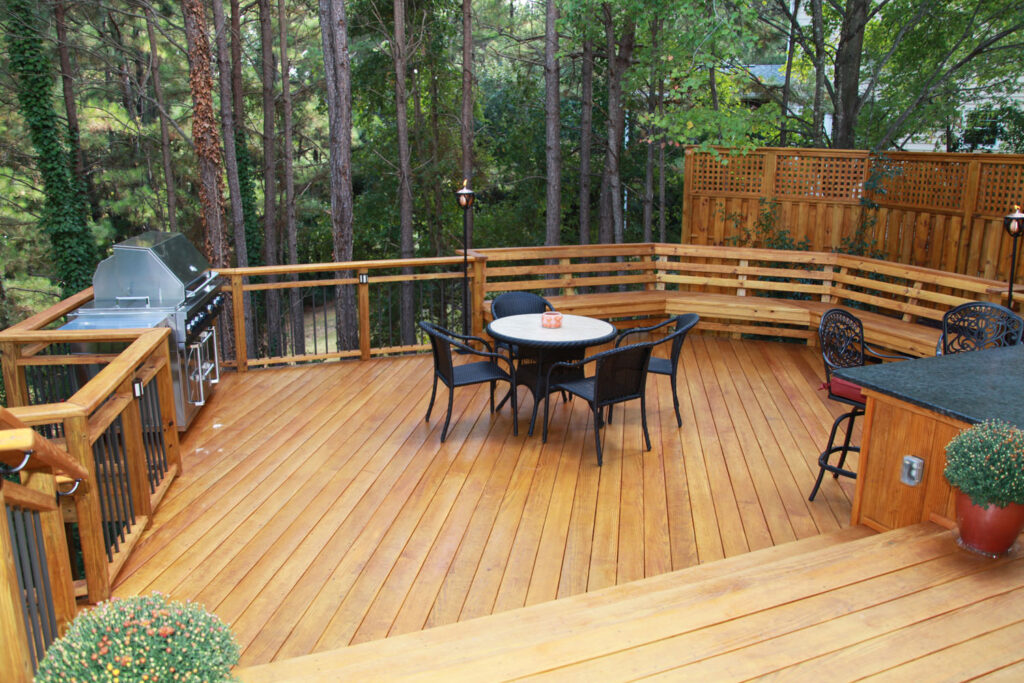Echtes Holz vs. Terrassendielen aus Verbundwerkstoff oder Kunststoff
ECHTES HOLZ vs
Terrassendielen aus Verbundwerkstoff
Während sich einige Hausbesitzer und Bauherren für Terrassendielen aus Verbundwerkstoff oder Kunststoff entscheiden, ist druckimprägnierte Südkiefer aus einer Vielzahl von Gründen immer noch die beliebteste Wahl.
Schönheit, Mehrwert und Komfort sind nur einige der Gründe, warum die Terrassen und Veranden von Southern Pine so beliebt sind, ganz zu schweigen davon, dass diese „Außenräume“ den Wohnraum eines Hauses für Unterhaltung und Entspannung im Freien erweitern.
Aber Terrassendielen, die Lauffläche der Terrasse, haben es schwer. Terrassendielen werden täglich durch Witterungseinflüsse und Fußgänger hart bestraft, und als sichtbarster Teil der Terrasse müssen sie hohe langfristige Erwartungen an Passform, Verarbeitung und Aussehen erfüllen.
Holz ist die beste Wahl für Outdoor-Projekte
, da andere Terrassenprodukte bis zu achtmal mehr Energie benötigen können als Holz.
Massivholz ist ein natürlich wachsendes und nachwachsendes Produkt, im Gegensatz zu Verbundwerkstoffen, die in der Regel aus erdölbasierten Materialien wie Polyethylen, Polypropylen, Polystyrol oder Polyvinylchlorid hergestellt werden.
Wenn Sie sich zwischen Southern Pine-Terrassendielen oder einer Kunststoff-/Verbundoption entscheiden müssen, sollten Sie Folgendes beachten:
- Ästhetisch
- Kosten
- Haltbarkeit
- Auswirkungen auf die Umwelt
- Langlebigkeit
- Instandhaltung
Letztendlich hängt die Wahl zwischen Holz- und Verbundterrassen von Ihren Prioritäten und Vorlieben ab. Wenn Sie Wert auf eine natürliche Ästhetik legen und bereit sind, Zeit in die Pflege zu investieren, können Holzterrassen die richtige Wahl sein.

| Question | Real Wood | Composites or Plastics | What are the facts? |
|---|---|---|---|
| Natural Appearance? | Yes | No | There is no substitute for the look and feel of real wood. Wood decking looks warm, natural, and blends beautifully with the landscape. Plastic or plastic composites, even with faux wood grain, still look and feel artificial. |
| Comfortable under foot? | Yes | ? | Wood is a naturally insulating material and does not conduct heat or cold like metal or plastic. In direct sun, some plastic or composite decking can become much hotter than wood, hot enough to burn or blister feet. |
| Safe to use? | Yes | Yes | Pressure-treated wood is safe for people, pets, and the environment. Furthermore, advanced preservative formulations contain no arsenical or chromium compounds while being resistant to decay and termite attack. |
| Renewable? | Yes | No | Wood is the only building material that uses the sun’s energy to renew itself in a continuous cycle. Sustainable forestry practices ensure our supply of homegrown wood will be maintained for future generations. On the other hand, plastics are derived from finite petroleum resources. |
| Earth-friendly? | Yes | No | Manufacturing wood products uses less energy and produces less air and water pollution than other building materials. Manufacturing plastic decking requires more energy to produce than a comparable piece of wood decking. |
| Strong? | Yes | No | Wood can be up to four times stronger than plastic or composite products and possesses up to nine times the stiffness of artificial decking. Wood decking is not affected by heat, which tends to promote creep (sagging) in composites over time. |
| Needs maintenance? | Yes | Yes | Despite claims to the contrary, all decking requires maintenance. Periodic cleaning and application of a water-repellant sealer is all that is needed to keep a wood deck in top shape. A good scrubbing usually removes most stains on wood decking, too. |
| Decay/termite warranty? | Lifetime limited | Limited | Wood preservative manufacturers typically offer a limited lifetime warranty against decay and termite attack in residential use. Plastic or composite deck manufacturers typically offer a limited warranty. |
| Standardized product? | Yes | No | Approved inspection agencies monitor lumber production and pressure-treating facilities. These agencies operate under rigorous protocols to enforce uniform performance and quality standards approved by the American Lumber Standard Committee and/or the American Wood Protection Association. |